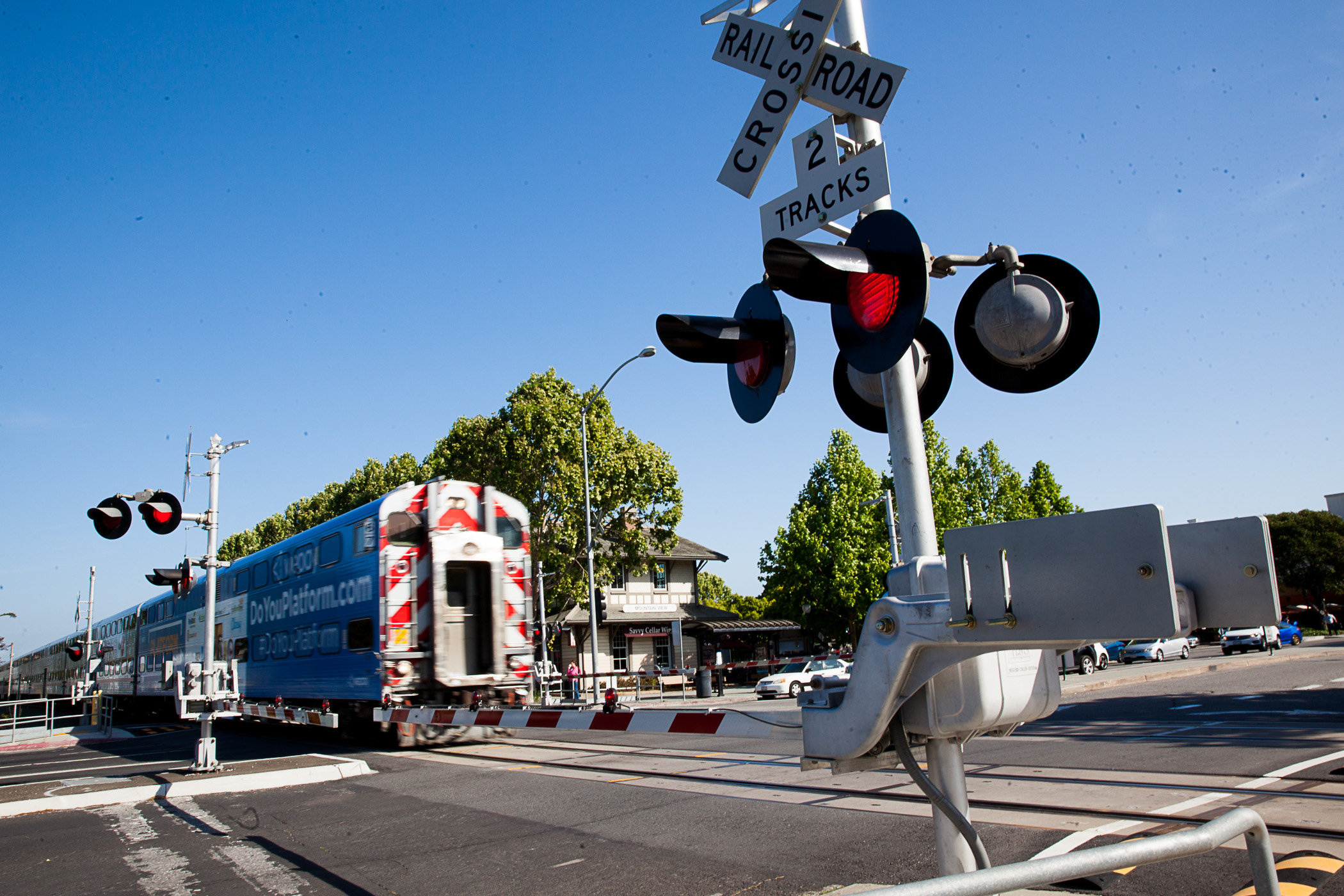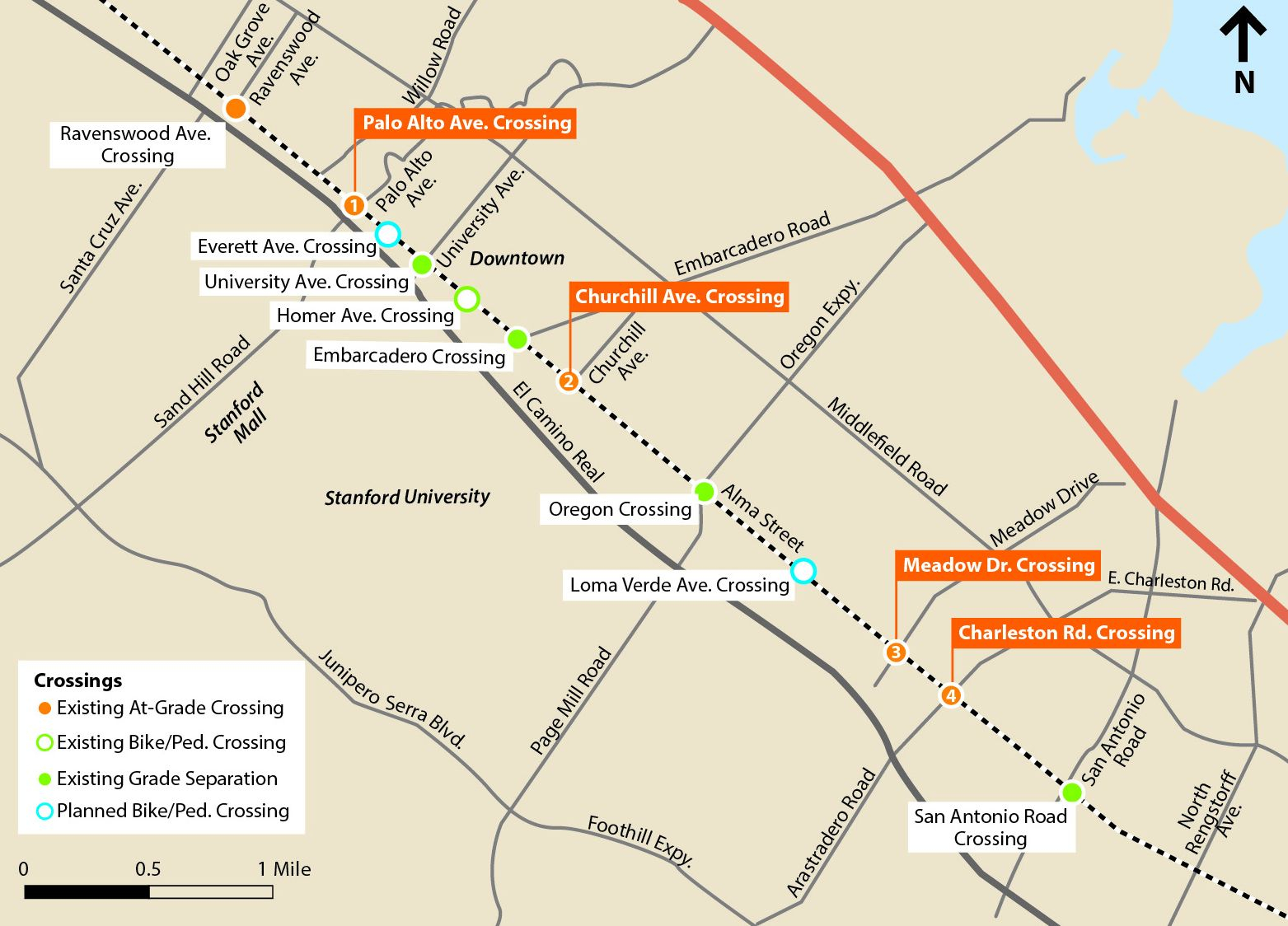In a move that they hope will boost their efforts to redesign Caltrain rail crossings, the cities of Palo Alto, Mountain View and Sunnyvale have struck a deal for splitting the $700 million that they are entitled to under Measure B for grade separation projects.
The deal, which is detailed in a letter that the Palo Alto City Council unanimously approved Monday night, calls for splitting the funding proportionately based on the number of grade crossings in each jurisdiction. Palo Alto, which has four of the eight rail crossings in north Santa Clara County — Palo Alto Avenue, Churchill Avenue, East Meadow Drive and Charleston Road — would get 50% of the funding under this formula. Mountain View and Sunnyvale, which have two rail crossings in their respective jurisdictions, would each get 25%
The deal has yet to be ratified by the Santa Clara Valley Transportation Authority, the regional transportation agency that is distributing the funds from the 2016 tax measure. But Palo Alto Vice Mayor Pat Burt and Sunnyvale Vice Mayor Glenn Hendricks, who serve on the VTA board of directors, have both come out strongly in support of the agreement. Burt told this news organization that his conversations with VTA staff have led him to believe that the agency will support the new pact.
If the VTA moves to formally endorse the formula proposed by the three cities, it would eliminate much of the financial uncertainty that has plagued the grade separation process in the three cities. While Measure B explicitly designates about $700 million for grade separation at the three cities, the measure had not laid out the exact mechanism for distribution. Palo Alto staff and some members of the council had repeatedly voiced concerns about falling behind the other two cities in planning for grade separation and losing out on county funding.
The agreement between the three cities would alleviate those anxieties by ensuring that the funds would not be divvied up on a use-it-or-lose-it basis, with shovel-ready projects getting to the front of the line. Instead, each city would get its share of the funding and then determine when, where and how it would spend it.
"The cities of Sunnyvale, Mountain View and Palo Alto have collectively come to this agreement and respectfully request that VTA accept this allocation plan for the life of the current 2016 Measure B Grade Separation fund," states the letter signed by Sunnyvale Mayor Larry Klein, Mountain View Mayor Ellen Kamei and Palo Alto Mayor Tom DuBois. "We look forward to working with VTA on its biannual budgeting process to identify more specifically when funds are needed as each city continues with its planning and environmental review process."
The agreement was hashed out by transportation planners from the three cities, who have been meeting as part of a subcommittee of the VTA's Technical Advisory Committee, Burt said. The collaboration grew stronger after VTA staff presented a contentious scenario last November that would have effectively frozen all spending on grade separations for decade and directed more Measure B funding in the near term to expanding BART service in San Jose.
The proposal solicited widespread backlash from members of the VTA board and the Santa Clara County Board of Supervisors, who characterized the move as a betrayal of the VTA's promise to the voters when it was seeking support for Measure B. After the VTA board voted to oppose the shifting of funding toward BART, agency staff quickly scuttled the scenario.
Burt noted that each of the cities believed that its particular projects would be costlier than those elsewhere. But after some initial discussion of different formulas for splitting the money, they ultimately agreed that attempting to divide the funds based on prospective costs would not be a winning proposition, he said.
Chip Taylor, public works director at Sunnyvale, said that staff from the three cities, including public works directors and transportation managers, considered various criteria, including the number of vehicles on each crossing and the multiple challenges each particular crossing faces. Each city, he told the council at the July 27 meeting, had hoped to "shift the money a little bit this way or a little bit that way."
Ultimately, they realized that all crossings have different challenges and complexities. Rather than devising criteria or ranking priorities, they agreed to split the money proportionately, based on the number of crossings.
"Let the cities deal with how they want to spend the money for their two crossings or the four crossings that they have inside their jurisdictions," Taylor said, summarizing the compromise.
Hendricks said he believes it is appropriate for the three cities to issue a recommendation on the grade separation funds. Hopefully, he said, the entire VTA board will ultimately accept this formula, he said, particularly since the agreement will not affect any other city.
"This is money that's allocated, that's only going to be used in those three cities, and those three cities should make that determination of how that is," Hendricks said at the July 27 meeting, just before the Sunnyvale City Council had voted unanimously to approve the letter.
If approved by the VTA, the agreement will both remove an important category of uncertainty in the planning process for grade separations and give each of the three cities a "big down payment" on their grade separation plans, Burt said. Each will now be able to leverage Measure B dollars to seek additional funding from regional, state and federal sources, he said.
"Measure B gave us something that's unusual, which is a major down payment that allows us, when we seek other funding, to already have a major share of the cost funded," Burt said.
Palo Alto City Manager Ed Shikada said at Monday's council meeting that the letter from the three mayors to the VTA solidifies the "handshake agreement" that staff from the three cities made about how the money would be spent. Mountain View is preparing to sign the letter as well, according to a report from Palo Alto's Office of Transportation.
"This will firm up the expectation that Palo Alto would receive 50% of that overall ($700 million) allocated for grade separation in the north county," Shikada said.
Meanwhile, Palo Alto is preparing to continue its discussion on grade separation alternatives on Aug. 23, when the council will be reviewing alternatives for the East Meadow and Charleston crossings.




Comments
Registered user
Old Mountain View
on Aug 12, 2021 at 12:13 pm
Registered user
on Aug 12, 2021 at 12:13 pm
What a pleasantly sensible resolution to this issue! Good job, local elected officials. And a hat tip to the PA Weekly/MV Voice for covering this important topic.
Registered user
St. Francis Acres
on Aug 12, 2021 at 3:27 pm
Registered user
on Aug 12, 2021 at 3:27 pm
Does the agreement also cover when funding might be available and to whom? Measure B will not generate $700M overnight and cities won't need the money at the same time (Palo Alto being far behind in planning).